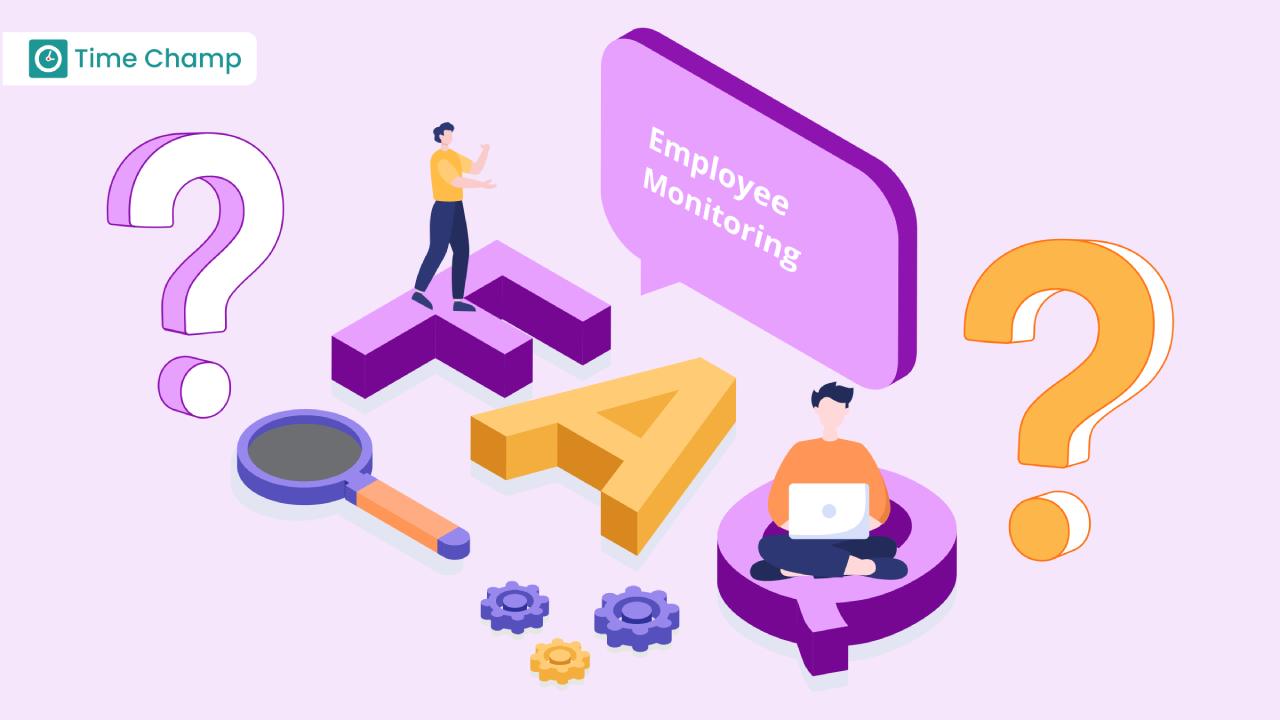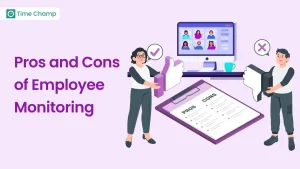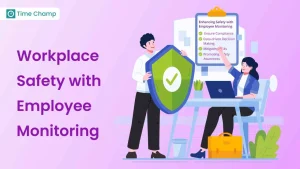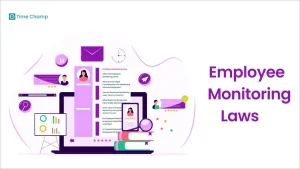Employee Monitoring is a key aspect of today’s modern workplace but still, there are so many doubts about using this software. Don’t worry, we are here to help with any type of doubt about this monitoring software. In this blog, we have addressed and covered all queries regarding this software, which helps to maximize your productivity and helps in the profitability of organizations.
1. What is Employee Monitoring?
Employee monitoring is the act of employers overseeing their employees’ activities, both in the physical and virtual space, during working hours, using different technologies and techniques. This can involve tracking computer usage such as websites accessed, typing, emails, software usage, and physical movements through GPS. The objectives of monitoring employees are usually to increase efficiency, enforce compliance with organizational standards, safeguard information, and for security purposes. However, employers must be careful not to infringe on employees’ privacy rights and should ensure that employees are aware of the monitoring process.
2. What are the Primary Reasons for Implementing Employee Monitoring?
Employee monitoring is primarily implemented to increase productivity and accountability through the identification of areas of inefficiency and unnecessary disruptions. It helps to ensure adherence to policies and regulations, safeguarding confidential data and ideas. Monitoring also enhances security measures by identifying and mitigating any intrusions and cyber risks. Also, it helps to manage a remote workforce and provides information for performance assessments and feedback.
3. How Does Employee Monitoring Software Work?
It gathers information from different sources like the company computers, devices, and networks. This includes the accessed websites, applications used, the keystrokes made, emails sent and received, and in some cases GPS location if relevant to the job.
After being collected, this data is stored in the software and processed to produce reports. These reports give information on the employees’ performance, their conduct in the workplace, and their conformity to the law. These reports are available to the employers through a user-friendly interface of the software developed.
4. What Metrics and Data Points are Typically Tracked Through Employee Monitoring?
Monitoring can be useful in terms of understanding the efficiency, security, and compliance of the employees. Below are the common measures:
- Time Spent in Work
- Internet Activity
- Activity Monitoring
- Productivity Metrics
- Keystrokes Monitoring
- Monitoring Mails
- Communication Monitoring
- Application Tracking
- Security Compliance
- Location Tracking
5. How Can Employee Monitoring Improve Productivity and Efficiency?
Employee monitoring enhances productivity because it allows employers to monitor how the employees spend their working hours. It assists in the detection and elimination of time wasters, for instance, spending too much time on social media or other unrelated activities while at work. Monitoring enables organizations to understand work patterns and productivity trends thus putting measures in place that will improve performance.
Furthermore, the monitoring of employees enhances efficiency since it offers details about the distribution of tasks and their completion. This helps the employers manage the resources, organize the workflow, and determine and address the problems that slow down the work. By tracking the timeline and the workflow of projects, the employee computer monitoring software assists organizations in running their operations more effectively, meeting their deadlines, and increasing the overall efficiency of the business.
6. What are the Pros and Cons of Employee Monitoring?
Employee monitoring can offer several benefits and drawbacks for both employers and employees:
Pros:
- Increases Productivity: It keeps the employees alert and not involved in other activities not related to work and helps identify areas that require improvement in efficiency, hence improving productivity.
- Improves Accountability: When employees are aware their activities are being observed, they are likely to stick to the set policies and work hard to meet organizational expectations, thus creating accountability.
- Enhances Security: Monitoring helps in ensuring that the company information is not leaked to the wrong people or channels by pointing out cases of, unauthorized access or potential breaches, hence protecting the information.
- Performance Evaluation: It provides statistical data on the employees and can be used to identify who deserves a promotion, who needs training, and who should be assigned more work to increase the efficiency of the team.
- Compliance: It also assists in preventing instances of non-adherence to the industry policies and procedures because the activities of the employees are documented and analyzed.
Cons:
- Privacy Concerns: Employees may feel their privacy is invaded, especially if monitoring includes personal communication or activities outside work hours.
- Decreases Morale: Constant monitoring can lead to stress, anxiety, or feelings of distrust among employees, affecting morale and job satisfaction.
- Potential for Misuse: Data collected through monitoring could be used unfairly or inaccurately in performance evaluations or disciplinary actions.
- Legal Issues: Monitoring practices must comply with employee privacy and monitoring laws, and misuse of monitoring data can lead to legal liabilities.
- Cost and Implementation: Setting up and maintaining monitoring systems can be costly, requiring investment in technology and resources.
Balancing the benefits of employee monitoring with ethical considerations and respect for privacy is crucial for maintaining a positive work environment and fostering trust between employers and employees.
7. What are the Types of Employee Monitoring Software?
Employee monitoring software comes in various types, each tailored to different aspects of tracking employee activities. Here are the common types:
- Computer Monitoring Software: Monitors the amount of time employees spend on the computer, active and idle time, applications used, and screensaver timeouts. It can monitor and analyze the employees’ computer usage to get information about their work patterns, productivity, and effectiveness.
- Internet Monitoring Software: It monitors the employee’s web usage, the sites they access, the time spent on each site, and the search queries made. This software helps employers monitor their employee’s internet usage and ensure they are not engaging in prohibited activities.
- Email Monitoring Software: Email monitoring software records the number of emails sent and received, the content of the emails, attachments, and the recipients. It can help employers prevent information leakage and keep track of the communication process.
- Time Tracking Software: Records and monitors the time spent by the employees, their tasks, and projects being worked on. Assists in the identification of areas for improvement, enhances the workflow, and makes proper resource choices. Helps employers to improve working efficiency, schedule projects, and appraise employees using time logs.
- GPS Tracking Software: It is used to track where employees are. This is especially important for remote or field workers. Employers can use GPS in company devices to ensure employees are in the right place at work. It also helps plan routes for field workers.
- Phone Monitoring Software: Records all the phone calls of the employees including the incoming and outgoing calls, the duration of the call, and sometimes even the actual call for communication analysis. It assists employers in being able to monitor whether business calls are being attended to in the right manner.
8. What are the Best Practices for Implementing Employee Monitoring?
- Define Clear Objectives: First, it is necessary to state the purpose of monitoring employees. Is it to increase efficiency, check that people are conforming to policies, or safeguard information? Understanding your objectives allows you to select the appropriate tools and keep your attention on the advantages.
- Communicate Transparently: Share with your team what you are monitoring and why you are doing it. Transparency strengthens trust and makes everyone aware of the benefits. It is easier to get people to support a decision when they understand what is going on and why it is happening.
- Limit Monitoring Scope: Limit the monitoring to work-related things only. Privacy should be respected, hence the need to avoid overdoing it or being too aggressive. Instead of concentrating on the number of hours worked, it is advised to pay attention to the results that are valuable for productivity and organizational objectives.
- Ensure Data Security: Ensure that you have put in place adequate security measures to ensure the data collected is secure. Confirm that you updated your security measures to ensure that everything is secure from any breach. In this way, you are safeguarding the company’s and your employees’ data.
- Maintain Compliance with Laws: Another aspect that should be considered is the legal compliance of your monitoring activities and their adherence to the local, state, or federal laws. It is also important to ensure that one is aware of any changes in the law and adjusts to the new changes. It not only assists you in not doing things that are unlawful but also assists you in doing the right things.
9. Is Employee Monitoring Legal?
Yes, it is legal to monitor employees, but the laws differ from country to country. In general, employers must have a proper purpose for monitoring and communicating this to the employees. The monitoring should not be invasive, and employees’ consent is usually necessary. The information gathered must be protected and used correctly as required by law. It is recommended to consult legal advisors conversant with the laws of the country in question.
10. What are the Ethical Considerations for Monitoring Employee Activities?
In observing the activities of the employees, there is always a conflict between the business requirements and the ethical issues. Several employee monitoring ethics should be considered when implementing the practice of monitoring the activities of employees to make the process fair, transparent, and non-intrusive to the employees’ rights. Below are the ethical considerations:
Transparency: Communicate to employees the monitoring and why it is being done.
Consent: Obtain explicit consent where possible.
Privacy: Respect personal privacy and limit monitoring to work-related activities.
Data Security: Protect collected data from unauthorized access.
Legal Compliance: Follow all relevant laws and regulations.
11. How Can Employers Effectively Monitor Remote Workers?
Remote monitoring software is useful for employers to monitor their remote employees. It monitors working hours, tracks which applications and websites are being visited, and even how efficiently employees are typing or how active they are. It is like having a window to the office to know who is working and who requires a little push. They also assist in recording attendance, project management, and ensuring that everyone is in harmony even when they are thousands of miles apart.
12. How Can Monitoring Data Be Used to Improve Employee Performance and Development?
This monitoring data is crucial in improving the performance of the employees and providing the managers with information on productivity. This way, the managers can see who is performing well, where there are problems, and whether goals are being met in terms of the time and completion rates of tasks and activities. This data enables feedback, workload balancing, and approaches to enhance team efficiency and effectiveness.
It also helps to identify training requirements for the employees’ growth by observing the patterns and deficiencies. This enables the managers to develop individual training plans that will enable the employees to grow and develop their skills continuously. This targeted approach increases the employees’ confidence, ensures that the professional development of the employees is in line with the organizational goals and objectives, and ensures that the training resources are effectively used to improve the competence and efficiency of the teams.
13. How Does Employee Monitoring Contribute to Data Security?
Monitoring is a crucial component of data protection because it offers details on how data is managed in an organization. This way, the employer can monitor any suspicious activity or a possible breach through activities like file access, emails, and data transfer. This real-time visibility is useful in preventing unauthorized access to data and its use, hence minimizing the chances of data loss or leakage.
Also, employee monitoring tools ensure that the organization complies with the set regulatory standards and internal security policies since the tools alert the administrators of any suspicious activities such as the opening of restricted files or transferring of large data. This approach helps to prevent the leakage of the company’s information and makes employees more cautious and aware of the security measures they should follow.
14. How Can Employers Choose the Right Monitoring Tools for Their Needs?
Choosing the right monitoring tools involves assessing your business’s specific needs, ensuring ethical and legal compliance, and considering the impact on employees. Here are key steps for employers to select the appropriate tools:
Identify Objectives and Requirements
Evaluate Features and Capabilities
Consider Privacy and Legal Compliance
Integration and Compatibility
Trail and Testing
Thus, the outlined steps will help employers select the most suitable monitoring tools while adhering to ethical principles and legal requirements.
Read more about monitoring tools: How to Choose the Right Monitoring Tools
15. Can Employee Monitoring Software Detect and Prevent Potential Cybersecurity Threats?
Yes, monitoring software can help detect and prevent possible cybersecurity and insider threats. These tools help to monitor the activity of the user and any suspicious activity, like access at odd hours or from a different location can be detected and reported. Supervising data transfers and access to restricted information also leads to the generation of alerts for unusual activities, thus preventing the leakage of data.
Also, such functions as keystroke logging and monitoring of internet access can identify phishing and unauthorized access to prohibited resources. Monitoring software with other security solutions forms a strong security layer, that helps IT departments be informed and quickly address threats. This cooperation provides full coverage and improves the general security level.
16. Are There Industry-specific Regulations or Guidelines for Employee Monitoring?
Yes, there are rules and regulations as well as guidelines that are set depending on the industry of the company. In areas such as finance and healthcare, there are specific guidelines to protect the data. There are legal requirements such as GDPR for the financial sector, SOX for financial institutions, and HIPAA for the healthcare sector.
Also, FERPA requires educational institutions to protect student data and technology companies may follow cybersecurity standards such as NIST. These regulations help achieve effective monitoring of the employees while ensuring that their privacy and legal rights are not infringed.
17. What Steps Can Employers Take to Ensure Employee Privacy While Monitoring?
- Clear Policies: It is recommended to begin with the written policies that describe why and how monitoring is performed. Transparency fosters trust and enables the employees to know what is being monitored and the reasons why it is being done.
- Anonymize Data: Employ technologies that obscure the data as much as possible. This ensures that the identity of the employees and other important information is not revealed while at the same time enabling the monitoring of trends and patterns.
- Focused Monitoring: Avoid monitoring your employees’ activities outside of work or personal matters that are not related to work. Do not interfere with personal issues that do not concern the productivity or security of an organization.
- Regular Audits: Perform periodic privacy impact assessments and reviews of monitoring procedures. It also ensures that the organization complies with the privacy laws and gets to know the areas that require change to enhance the privacy of the employees.
- Educate Employees: Educate the employees on the monitoring policies, their rights concerning data protection, and the importance of monitoring in security and performance. Communication promotes respect for the privacy of others in the workplace and courtesy to fellow employees.
18. How to Detect Employee Monitoring Software?
It is important to know if you are being monitored at work since it is your right not to be spied on at your workplace. It is crucial to be aware of the existence of monitoring tools for work and productivity enhancement or security purposes, but they should be used legally and ethically. Finding these tools may not be easy, but there are some signs and methods to determine whether monitoring software is running on your computer. Let’s discuss some of the most efficient techniques that can be used to detect and identify any monitoring software that may be installed on the work device.
Use the Command Line
Check the Task Manager
Install Anti-Spyware Software
Signs of Stealth Mode Operation
Network Traffic Analysis
Use these methods. They can increase your odds of finding monitoring software. Then, you can address privacy or unauthorized surveillance concerns.
Read more about: How to Detect Monitoring Software
19. How Employees May Trick This Software?
There are several strategies that employees may use to deceive monitoring software. Some may fake work by occasionally moving the mouse or typing anything incoherently to give an impression of working. Some might employ software or scripts that mimic activity, and therefore give the impression of working on the tasks.
Also, employees may attempt to avoid monitoring by using their own devices or connecting to other networks, not under surveillance, for instance, free Wi-Fi. They could also change their internet usage profile or modify their privacy settings to hide their activities. These strategies are designed to avoid detection or give a misleading appearance of work while avoiding detection by the monitoring tools. Employers must remain alert and develop effective monitoring measures that consider these evasion possibilities.
20. How Can Employee Monitoring Be Integrated with Existing HR Systems?
The integration of employee monitoring with other HR systems can be beneficial in terms of organization and productivity.
Assess Compatibility: Ensure monitoring tools are compatible with current HR software.
Choose the Right Tools: Select tools with APIs or built-in integrations for seamless data exchange.
Set Up Data Synchronization: Configure real-time or regular data sync between systems.
Ensure Data Security: Implement strong security measures and comply with privacy regulations.
Train HR Staff: Provide training on new workflows and data utilization.
In this way, employers can successfully implement employee monitoring tools into the existing HR systems, which will result in increased productivity, more efficient use of data, and overall improvement of the HR field.
Conclusion
These are the 20 most asked questions about employee monitoring. We’ve covered key concepts and queries related to monitoring software, helping organizations make informed decisions while balancing productivity and privacy.
Deploying employee-monitoring software like Time Champ is considered an effective method. Time Champ helps maintain a healthy balance between the employer’s business interests and the team’s privacy.
Ready to implement effective employee monitoring solutions?
Discover more insights and make informed decisions by visiting Time Champ today!
Signup for FreeBook Demo






